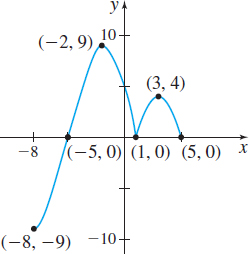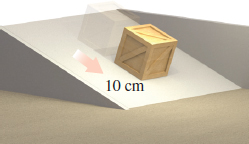REVIEW EXERCISES
340
Question
Related rates A spherical snowball is melting at the rate of \(2\) \({\rm{cm}}^3/\min\). How fast is the surface area changing when the radius is \(5\) cm?
Question
Related rates A lighthouse is \(3\, {\rm km}\) from a straight shoreline. Its light makes one revolution every \(8\) seconds. How fast is the light moving along the shore when it makes an angle of \(30^{ {\circ }}\) with the shoreline?
Question
Related rates Two planes at the same altitude are approaching an airport, one from the north and one from the west. The plane from the north is flying at \(250\, {\rm mph}\) and is \(30\) mi from the airport. The plane from the west is flying at \(200 \,{\rm mi}/{\rm h}\) and is \(20 \,{\rm mi}\) from the airport. How fast are the planes approaching each other at that instant?
It In Problems 4 and 5, use the graphs below to determine whether each function has an absolute extremum and/or a local extremum or neither at the indicated points.
Question

Question

Question
Critical Numbers \(f(x)=\dfrac{ x^{2}}{2x-1}\)
- Find all the critical numbers of \(f\).
- Find the local extrema of \(f.\)
Question
Critical Numbers Find all the critical numbers of \(f(x)=\cos (2x) \) on the closed interval \([0,\pi ]\).
It In Problems 8 and 9, find the absolute maximum value and absolute minimum value of each function on the indicated interval.
Question
\(f(x) =x-\!\sin (2x) \) on \([0,2\pi]\)
Question
\(f(x) =\) \(\dfrac{3}{2}x^{4}-2x^{3}-6x^{2}+5\) on \([-2, 3]\)
Question
Rolle’s Theorem Verify that the hypotheses for Rolle’s Theorem are satisfied for the function \(f(x)=x^{3}-4x^{2}+4x\) on \([0,2].\) Find the coordinates of the point(s) at which there is a horizontal tangent line to the graph of \(f\).
Question
Mean Value Theorem Verify that the hypotheses for the Mean Value Theorem are satisfied for the function \(f(x)=\dfrac{2x-1}{x}\) on the interval \([1,4].\) Find a point on the graph of \(f\) that has a tangent with a slope equal to that of the secant line joining \((1,1) \) to \( \left( 4,\dfrac{7}{4}\right).\)
Question
Mean Value Theorem Does the Mean Value Theorem apply to the function \(f(x)=\sqrt{x}\) on the interval \([0,9]\)? If not, why not? If so, find the number \(c\) referred to in the theorem.
In Problems 13–15, find the local extrema of each function:
- Using the First Derivative Test.
- Using the Second Derivative Test, if possible. If the Second Derivative Test cannot be used, explain why.
Question
\(f(x)=x^{3}-x^{2}-8x+1\)
Question
\(f(x)=x^{2}-24x^{2/3}\)
Question
\(f(x)=x^{4}e^{-2x}\)
Question
Rectilinear Motion The distance \(s\) of an object from the origin at time \(t\) is given by \(s=s(t) =t^{4}+2t^{3}-36t^{2}\). Draw figures to illustrate the motion of the object and its velocity.
In Problems 17–22, graph each function. Follow the steps given in Section 4.6.
Question
\(f(x)=-x^{3}-x^{2}+2x\)
Question
\(f(x)=x^{1/3}(x^{2}-9)\)
Question
\(f(x)=xe^{x}\)
Question
\(f(x) =\dfrac{x-3}{x^{2}-4}\)
Question
\(f(x)=x\sqrt{x-3}\)
Question
\(f(x) =x^{3}-3\ln\;x\)
In Problems 23 and 24, for each function:
- Determine the intervals where each function is increasing and decreasing.
- Determine the intervals on which each function \(f\) is concave up and concave down.
- Identify any inflection points.
341
Question
\(f(x)=x^{4}+12x^{2}+36x-11\)
Question
\(f(x)=3x^{4}-2x^{3}-24x^{2}-7x+2\)
Question
If \(y\) is a function and \(y\prime >0\) for all \(x\) and \( y{\prime \prime} <0\) for all \(x\), which of the following could be part of the graph of \(y=f(x)\) ? See illustrations (A) through (D).

Question
Sketch the graph of a function \(f\) that has the following properties:
\(f(-3)=2;~f(-1)=-5;~f(2)=-4;\)
\(f(6)=-1~f'(-3) = f^\prime (6)=0\)
\(\lim\limits_{x\rightarrow 0^{-}}f(x)=-\infty;~\lim\limits_{x \rightarrow 0^{+}}f(x)=\infty;\)
\(f^{\prime \prime} (x)>0 \hbox{ if } x<-3 \hbox{ or } 0<x<4\)
\(f^{\prime\prime} (x)<0 \hbox{ if } -\!3<x<0 \hbox{ or } 4<x\)
Question
Sketch the graph of a function \(f\) that has the following properties:
\(f(-2)=2; f(5)=1; f(0)=0\)
\(f^\prime (x)>0 \hbox{ if } x<-2 \hbox{ or } 5<x\)
\(f^\prime (x)<0 \hbox{ if }\;-2<x<2 \hbox{or } 2<x<5\)
\(f^{\prime \prime} (x)>0 \hbox{ if } x<0 \hbox{ or } 2<x\;{\rm {and}}\;f^{\prime \prime} (x)<0 \hbox{ if } 0<x<2\)
\(\lim\limits_{x\rightarrow 2^{-}}f(x)=-\infty \lim\limits_{x\rightarrow 2^{+}}f(x)=\infty\)
Question
Mean Value Theorem For the function \(f(x)=x\sqrt{x+1},\) \(0\leq x\leq b\), the number \(c\) satisfying the Mean Value Theorem is \(c=3\). Find \(b\).
Question
Maximizing Volume An open box is to be made from a piece of cardboard by cutting squares out of each corner and folding up the sides. If the size of the cardboard is \(2 \,{\rm ft}\) by \(3 \,{\rm ft}\), what size squares (in inches) should be cut out to maximize the volume of the box?
Question
Minimizing Distance Find the point on the graph of \(2y=x^{2}\) nearest to the point \((4,1)\).
In Problems 31–38, find all the antiderivatives of each function.
Question
\(f(x) =0\)
Question
\(f(x) =x^{1/2}\)
Question
\(f(x) =\cos x\)
Question
\(f(x) =\sec x\tan x\)
Question
\(f(x) =\dfrac{2}{x}\)
Question
\(f(x) =-2x^{-3}\)
Question
\(f(x)=4x^{3}-9x^{2}+10x-3\)
Question
\(f(x)=e^{x}+\dfrac{4}{x}\)
Question
Velocity A box moves down an inclined plane with an acceleration \(a(t) = \) \(t^{2}(t-3)\)\({\rm{cm/s}}^2 \). It covers a distance of \(10 \,{\rm cm}\) in \(2 \,{\rm seconds}\). What was the original velocity of the box?

Question
Free Fall Two objects begin a free fall from rest at the same height \(1\) second apart. How long after the first object begins to fall will the two objects be \(10 \,{\rm m}\) apart?
In Problems 41–44, determine if the expression is an indeterminate form at \(0\). If it is, identify its type.
Question
\(\dfrac{xe^{3x}-x}{1-\cos (2x) }\)
Question
\(\left( \dfrac{1}{x}\right) ^{\tan x}\)
Question
\(\dfrac{1}{x^{2}}-\dfrac{1}{x^{2}\sec x}\)
Question
\(\dfrac{\tan x-x}{x-\!\sin x}\)
In Problems 45–56, find each limit.
Question
\(\lim\limits_{x\rightarrow {\pi }/{2}}\dfrac{\sec ^{2}x}{\sec ^{2}(3x) }\)
Question
\(\lim\limits_{x\rightarrow 0}\left[ \dfrac{2}{\sin ^{2}x}-\dfrac{1}{1-\cos x}\right] \)
Question
\(\lim\limits_{x\rightarrow 0}\dfrac{e^{x}-e^{-x}}{\sin x} \)
Question
\(\lim\limits_{x\rightarrow 0^{-}}x\;\cot \left( \pi x\right) \)
Question
\(\lim\limits_{x\rightarrow 0}\dfrac{\tan x+\sec x-1}{\tan x-\sec x+1}\)
Question
\(\lim\limits_{x\rightarrow a}\dfrac{ax-x^{2}}{a^{4}-2a^{3}x+2ax^{3}-x^{4}}\)
Question
\(\lim\limits_{x\rightarrow 0}\dfrac{x-\!\sin x}{x^{3}}\)
Question
\(\lim\limits_{x\rightarrow 0}\dfrac{\tan x-\!\sin x}{\sin ^{3}x}\)
Question
\(\lim\limits_{x\rightarrow \infty }(1+4x)^{2/x}\)
Question
\(\lim\limits_{x\rightarrow 1}\left[ \dfrac{2}{x^{2}-1}-\dfrac{1}{x-1}\right] \)
Question
\(\lim\limits_{x\rightarrow 4}\dfrac{x^{2}-16}{x^{2}+x-20}\)
Question
\(\lim\limits_{x\rightarrow 0^{+}}(\cot x)^{x}\)
In Problems 57–60, find the solution of each differential equation having the given boundary conditions.
Question
\(\dfrac{\textit{dy}}{\textit{dx}}=e^{x}\), when \(x=0\), \(y=2\)
Question
\(\dfrac{\textit{dy}}{\textit{dx}}=\dfrac{1}{2}\sec x\tan x,\) when \(x=0,\) \(y=7\)
Question
\(\dfrac{\textit{dy}}{\textit{dx}}=\dfrac{2}{x}\), when \(x=1,\) then \(y=4\)
Question
\(\dfrac{d^{2}y}{dx^{2}}=x^{2}-4,\) when \(x=3\), \(y=2,\) when \(x=2,\) \(y=2\)
342
Question
Maximizing Profit A manufacturer has determined that the cost \(C\) of producing \(x\) items is given by \(C(x) =200+35x+ 0.02x^{2}\) dollars. Each item can be sold for \({\$}78\). How many items should she produce to maximize profit?
Question
Optimization The sales of a new stereo system over a period of time are expected to follow the logistic curve \[ f(x)=\frac{5000}{1+5e^{-x}} \qquad x\geq 0 \]
where \(x\) is measured in years. In what year is the sales rate a maximum?
Question
Maximum Area Find the area of the rectangle of largest area in the fourth quadrant that has vertices at \((0,0)\), \((x,0)\), \(x>0\), and \((0,y)\), \(y<0\). The fourth vertex is on the graph of \(y=\ln x\).
Question
Differential Equation A motorcycle accelerates at a constant rate from \(0\) to \(72 \,{\rm km}/{\rm h}\) in 10 seconds. How far has it traveled in that time?